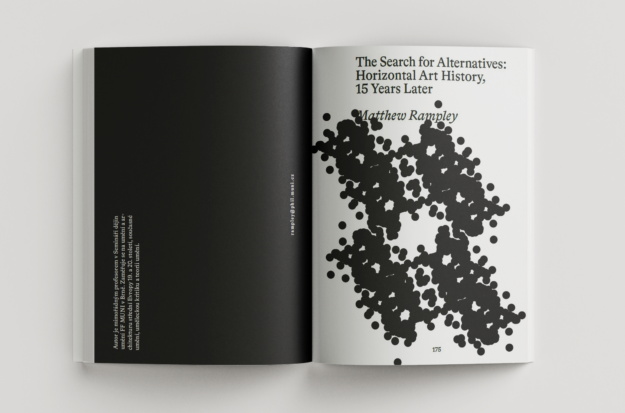The 34th issue of Notebook for Art, Theory and Related Zones brings together texts on specific trends in contemporary artistic production as well as theoretical and historical reflections on art in general. In the first text, “A Reduced Tolerance for Overlap”, Tereza Hadravová provides an introduction to the ideas of the American aesthetician Susanne K. Langer and finds a way to apply the classical categories Langer applies to art forms in order to interpret contemporary work. Using the example of A Hundred Women by Alfredo Jaar, she proposes that we understand certain works of contemporary visual art as a type of literature. Tereza Špinková entitled her observations regarding non-anthropocentric tendencies “Co-Existence With the Animal”. She notes how thinking about the role of animals in art has changed over the last thirty years, among other things under the influence of posthumanism and critical animal studies. For a concrete illustration of these trends she has chosen the work of Denisa Langrová and David Přílučík, who assign animals a unique place in their output. In the last reviewed study entitled “What Prevents Us from Imagining a Plausible Future”, Marika Volfová and Mikuláš Černík, without concealing their background in climate activism, explore the possibilities of imagining socio-economic transformation based on an evaluation of a series of workshops they held in the past at several educational and artistic institutions. The second half of this issue of Notebook is devoted to the legacy of the Polish art historian Piotr Piotrowski. It opens with a Czech translation of his text From Global to Alter-Globalist Art History (2012), in which he reacts to the ideas of decolonisation. This is followed by two shorter essays reflecting upon Piotrowski’s attempts to find a new methodology of art history. Milena Bartlová sets forth the historical circumstances surrounding the creation of Piotrowski’s texts and examines his reception in the Czech Republic, pointing out the country’s failure to come to terms with post-colonialism. In an essay written in English, Mathew Rampley focuses on Piotrowski’s text On the Spatial Turn, picking up on its criticism of an overly homogeneous understanding of Europe and the West.
Content
Tereza Hadravová
Reduced Tolerance to Crossovers. Susanne K. Langer and Contemporary Art
The aim of this paper is to provide an introduction to the aesthetics of art forms proposed by Susanne K. Langer and to outline two ways of thinking about contemporary art, which seems to be characteristically hostile to art kind classification, in her terms. First, I interpret the concepts of primary and secondary illusions that she coined and argue that her theory of individual art kinds does not depend on the medium. Next, I present an installation A Hundred Women (2014) by Alfred Jaar, which serves as an example of contemporary art. I suggest that a characteristic feature of contemporary art is the creation of secondary illusions bereft of primary illusions. As an alternative, I propose understanding contemporary art as literature.
Tereza Špinková
Becoming-with an Animal. A Few Notes on Contemporary Nonanthropocentric Tendencies
The paper contributes to the current discussion concerning the position of animals in contemporary art in the context of nonanthropocentric discourses. Significant changes have taken place in the field of natural sciences, social sciences and humanities in the last thirty years or so, with parallels in art. These changes concern a more consistent understanding of animals as living, feeling and acting subjects and individuals, rather than objects for human use. The text focuses primarily on the premises of posthumanism. It presents several motifs from the thinking of two theoreticians, Donna Haraway and Rosi Braidotti, briefly introduces the international context and then describes the specifics of the Czech environment. The main aim of the article is to show how visual art and the theories intertwined with it deal with new ethical challenges regarding freedom, rights and the treatment of animals. The selected artworks, created in the Czech Republic in the last few years and working with the medium of video, are meant to suggest tendencies about the need for a certain collaboration with animals, in this case with domesticated mammals.
Marika Volfová, Mikuláš Černík
What Prevents Us From Imagining Suitable Futures? The Pitfalls of Imagining Social-Ecological Transformation
Radical imagination has become an increasingly frequent term in the arts and social sciences. In the text, we describe the experience of organizing four workshops focused on the collective creation of ideas on solutions to the climate crisis, which we facilitated between 2019 and 2021 in artistic and educational institutions. In the introduction, we summarize the sources of inspiration for our thinking about imagination. Then, we contextualize imagination as a tool fostering emancipatory tendencies within social, political and economic transformations. Subsequently, we describe the workshop‘s structure, progress and specifics. Based on the evaluation of the workshop outputs, we identify frequently appearing limitations to the imagination of possible social interventions. We also reflect on the challenges we faced as organizers when preparing and conducting imaginative exercises. Our ambition is to encourage both social movements and art institutions to enhance their efforts on overcoming contemporary unsustainable socio-ecological regimes.
Piotr Piotrowski
From Global to Alter-globalist Art History
Translation of the text “Od globajnej do alterglobalistycznej historii sztuki”, Teksty Drugie, 2013, no. 1-2, pp. 269-291. English edition: ‘From Global to Alter-globalist Art History’, Teksty Drugie, 2015, no. 1, pp. 112-134.
Translated from the Polish original by Justyna Suma and Hana Blažková.
Milena Bartlová
Piotr Piotrowski is coming to the Czech Republic
The first shorter essay reflects Piotrowski’s efforts to develop a new methodology of art history. Milena Bartlová explains the specific historical circumstances of the creation of Piotrowsky’s texts and, above all, his reception in the Czech Republic, pointing out, among other things, our insufficient settlement with postcolonialism.
Matthew Rampley
The Search for Alternatives: Horizontal Art History, 15 Years Later
In an essay written in English, Mathew Rampley focuses on Piotrowski’s text On the Spatial Turn, picking up on its criticism of an overly homogeneous understanding of Europe and the West.



